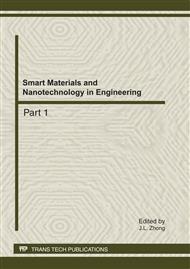[1]
Gao X, Cui Y, Levenson R M, et al. In vivo cancer targeting and imaging with semiconductor quantum dots [J]. Nat Biotechnol, 2004, 22 (8): 969-976.
DOI: 10.1038/nbt994
Google Scholar
[2]
Gao X, Yang L, Petros J A, et al. In vivo molecular and cellular imaging with quantum dots [J]. Curr Opin Biotechnol, 2005, 16(1): 63-72.
Google Scholar
[3]
Jaiswal J K, Mattoussi H, Mauro J M, et al. Longrterm multiple color imaging of live cells using quantum dot bioconjugates [J]. Nat Biotechnol, 2003, 21(1): 47-51.
DOI: 10.1038/nbt767
Google Scholar
[4]
Dahan M, Levi S, Luccardini C, et al. Diffusion dynamics of glycine receptors revealed by singlerquantum dot tracking [J]. Science, 2003, 302 (17): 442-445.
DOI: 10.1126/science.1088525
Google Scholar
[5]
Mattheakis L C, Dias J M, Choi Y J, et al. Optical coding of mammalian cells using semiconductor quantum dots [J]. Anal Biochem, 2004, 327 (2): 200-208.
DOI: 10.1016/j.ab.2004.01.031
Google Scholar
[6]
Akerman M E, Chan W C, LaakkonenP, et al. Nanocrystal targeting in vivo [J]. Proc Natl Acad Sci USA, 2002, 99(20): 12617-12621.
DOI: 10.1073/pnas.152463399
Google Scholar
[7]
Parak W J, Pellegrino T, Plank C. Labelling of cells with quantum dots[J]. Nanotechnology, 2005, 16(2): R9-R25.
DOI: 10.1088/0957-4484/16/2/r01
Google Scholar
[8]
Goldman E R, Anderson G P, Tran PT, et al. Conjugation of luminescent quantum dots with antibodies using an engineered adaptor protein to provide new reagents for fluoroimmunoassays[J]. Anal Chem, 2002, 74 (4): 841 -847.
DOI: 10.1021/ac010662m
Google Scholar
[9]
Jaiswal J K, Goldmen E R, MattoussiH, et al. Use of quantum dots for live cell imaging [J]. Nat Methods, 20041(1): 73-78.
Google Scholar
[10]
Voura E B, Jaiswal J K, Mattoussi H, et al. Tracking metastatic tumor cell extravasation with quantum dot nanocrystals and fluorescence emissionrscanning microscopy [J]. Nat Med, 2004, 10(9): 993-998.
DOI: 10.1038/nm1096
Google Scholar
[11]
Dubertret B, Skourides P, Norris D J, et al. In vivo imaging of quantum dots encapsulated in phospholipids micelles [J]. Science, 2002, 298 (29): 1759 - 1762.
DOI: 10.1126/science.1077194
Google Scholar
[12]
Pinaud F, King D, Moore H P, et al. Bioactivation and cell targeting of semiconductor CdSe/ZnS nanocrystals with phytochelatinrrelated peptides [J]. J Am Chem Soc, 2004, 126(19): 6115-6123.
DOI: 10.1021/ja031691c
Google Scholar
[13]
Ballou B, Lagerholm B C, Ernst L A, et al. Noninvasive imaging of quantum dots in mice [J]. Bioconjuate Chem, 2004, 15(1): 79-86.
DOI: 10.1021/bc034153y
Google Scholar
[14]
Sukhanova A, Devy J, Venteo L, et al. Biocompatible fluorescent nanor crystels for immunolabeling of membrane proteins and cells [J]. Anal Biochem, 2004, 324(1): 60-67.
DOI: 10.1016/j.ab.2003.09.031
Google Scholar
[15]
Stsiapura V, Sukhanova A, Artemyev M, et al. Functionalized nanocrystalr tagged fluorescent polymer beads: synthesis, physicochemical characterir zation, and immunolabeling application [J]. Anal Biochem, 2004, 334(2): 257-265.
DOI: 10.1016/j.ab.2004.07.006
Google Scholar
[16]
Kim S, Lim Y T, Soltesz E G, et al. Nearrinfrared fluorescent type II quantum dots for sentinel lymph node mapping [J]. Nat Biotechnol, 2004, 22(1): 93-97.
DOI: 10.1038/nbt920
Google Scholar
[17]
Lidke D S, Nagy P, Heintzmann R, et al. Quantum dot ligands provide new insights into erbB / HER receptor mediated signal transduction [J]. Nat Biotechnol, 2004, 22 (2): 198-203.
DOI: 10.1038/nbt929
Google Scholar
[18]
Li Y, Tang Z Y, Ye S L, et al. Establishment of cell clones with different metastatic potential from the metastatic hepatocellular carcinoma cell line MHCC97 [J]. World J Gastroenterol, 2001, 7(5): 630-636.
DOI: 10.3748/wjg.v7.i5.630
Google Scholar
[19]
Pellegrino T , et al. Hydrophobic nanocrystals coated with an amphiphilic polymer shell: a general route to water soluble nanocrystals[J]. Nano Lett. 2004. 4: 703-707.
DOI: 10.1021/nl035172j
Google Scholar
[20]
Alivisatos P. The use of nanocryatals in biological detection[J]. NatBiotechnol, 2004, 22(1): 47-52.
Google Scholar
[21]
Michalet X, Pinaud FF, Bentolila LA, et al. Quantum dots for live cells, in vivo imaging, and diagnostics[J]. Science, 2005, 307(5709): 538-544.
DOI: 10.1126/science.1104274
Google Scholar
[22]
Tanke HJ, Dirks RW, Raap T. Fish and immunocytochemistry: Towards visualising single target molecules in living cells[J]. Curr Opin Biotechnol, 2005, 16(1): 49-54.
DOI: 10.1016/j.copbio.2004.12.001
Google Scholar
[23]
Gao X, Yang L, Petros JA, et al. In vivo molecular and cellular imaging with quantum dots[J]. Curr Opin Biotechnol, 2005, 16(1): 63-72.
Google Scholar


